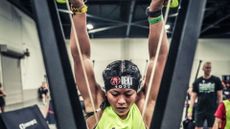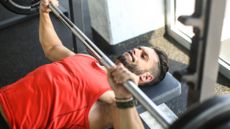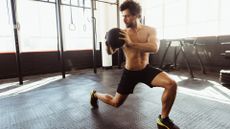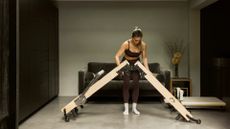

Want to get a six-pack fast? Well, you can’t. But there is one rule we’ve found that helps to speed up your muscle growth. In conjunction with the best abs workout or this 15-minute six-pack home workout, it can give you a flatter stomach. This isn’t a tip for those who want easy solutions, as it requires some thought. And some maths.
To maximise your gains you have to keep an eye on eating right and sleeping/resting enough. But you already knew that, right? We have some strategies for weight loss and the latest wave of running watches give some great insights into the training load and rest required.
What we’re looking at here is the third part of the holy trinity of workout wisdom: how to increase the volume of your exercise steadily and safely.
So, what is volume, and how do you turn it up?
Upping the volume incrementally is probably the best thing you can do in the gym if you want to build muscle mass quicker and see real progress in the church of iron sooner.
It is dead simple to count volume: just multiply the amount sets and reps you do with the weights you are lifting. Counting volume makes even a not so complicated push-pull-legs workout even simpler because you have to concentrate only on one number.
The formula looks like this:
Sign up to the T3 newsletter for smarter living straight to your inbox
Get all the latest news, reviews, deals and buying guides on gorgeous tech, home and active products from the T3 experts
Volume = weight x sets x reps
So, if you are doing 4 sets of 8 reps with 50 kg on the ab crunch machine, your volume is 4 x 8 x 50 kg=1,600 kg. Next time you use the ab crunch machine, probably the week after, try to increase the volume slightly. You can try lifting heavier weights or increasing the reps.
To do 1,650 kg, you can drop the sets down to 3, increase the reps to 10 and the weight to 55kg. The week after, you can do 2 sets of 8 reps and 2 sets of 9 reps with 50 kg, which would give you 1,700 kg.
By increasing the load slightly and playing around with the resp/sets, you will put your muscles in a constant state of muscle confusion. Muscle confusion is great to keep your muscles on their toes, so they won't get used to the training. This will help them grow faster and you to actually get stronger too.
Don't forget your protein
You probably already know this but you will need to take enough protein if you want your muscles to grow. If you are doing strength training, try taking in at least around 2 grams of protein for each kilogram of body weight per day.
So, if you weigh 70 kg, you'll need to eat 140 grams of protein per day. Humans haven't got protein reserves, so you have to continuously take protein in throughout the day.
Creatine is also recommended if you're doing strength training. You don't have to take much – one scoop is around 5 grams – and it will help you push just a little bit more in the gym. Get the unflavoured variety and you can mix it with any drink, even water or coffee.
Pre-workout supplements can also give you a bit of a boost if you really need some oomph. The main ingredient in those is caffeine, so the effect will depend on how much your coffee/tea drink during the day. But if you aren't over-abusing caffeine (which you shouldn't anyway), you will feel the extra energy.
As with all supplements, please always read the packaging for instructions on dosage recommendations.
On warmups and stretching
To avoid any injuries and to help recovery, stretch after every strength training session (and after every cardio session as well). Foam rollers can be found in most gyms, a quick and inexpensive way to massage tired muscles. You can also use massage guns for warm-ups.
Resistance bands are not only great for workouts but they are also an effective way to stretch your hamstrings after you did your squats.

Matt Kollat is a journalist and content creator who works for T3.com and its magazine counterpart as an Active Editor. His areas of expertise include wearables, drones, fitness equipment, nutrition and outdoor gear. He joined T3 in 2019. His byline appears in several publications, including Techradar and Fit&Well, and more. Matt also collaborated with other content creators (e.g. Garage Gym Reviews) and judged many awards, such as the European Specialist Sports Nutrition Alliance's ESSNawards. When he isn't working out, running or cycling, you'll find him roaming the countryside and trying out new podcasting and content creation equipment.
-
 When is Black Friday 2024 – this Friday or next? Here's the official answer
When is Black Friday 2024 – this Friday or next? Here's the official answerBlack Friday is on 29 November in 2024 – a week later than the year previous. But that's not stopped retailers putting on their sales...
By Mike Lowe Published
-
 Forget Black Friday, F1 24 is completely free for a limited time
Forget Black Friday, F1 24 is completely free for a limited timeThis top racing game has a free weekend
By Max Freeman-Mills Published
-
 What is Spartan’s DEKA fitness challenge?
What is Spartan’s DEKA fitness challenge?The race designed for all fitness levels tests strength, speed and endurance
By Bryony Firth-Bernard Published
-
 This single exercise drastically strengthened my core – but it’s not what you think it is
This single exercise drastically strengthened my core – but it’s not what you think it isThere's no lying down involved and it's not your typical core exercise either
By Bryony Firth-Bernard Published
-
 Can feeler sets help you lift more weight in the gym?
Can feeler sets help you lift more weight in the gym?This warm-up technique could make all the difference between a 'good' and 'bad' workout
By Bryony Firth-Bernard Last updated
-
 Jefferson curls: the unusual exercise to strengthen your lower back and core muscles
Jefferson curls: the unusual exercise to strengthen your lower back and core musclesAre you doing these in your warm-ups and cool-downs?
By Bryony Firth-Bernard Published
-
 4 Elite athletes share their best advice to prepare for a HYROX
4 Elite athletes share their best advice to prepare for a HYROXBecause who better to get some words of wisdom from than the pros themselves, right?
By Bryony Firth-Bernard Published
-
 Skip the sit-ups – these 7 standing core exercises actually build midsection muscle
Skip the sit-ups – these 7 standing core exercises actually build midsection muscleThese PT-approved exercises boost core strength and improve posture, for healthier movement
By Bryony Firth-Bernard Published
-
 R.A.D® walks into the wild side with adventure-ready apparel
R.A.D® walks into the wild side with adventure-ready apparelThe collection is made with Polartec Thermal Pro, to keep you warm without weighing you down
By Bryony Firth-Bernard Published
-
 Ditch the gym – the FOLD Reformer turns your home into a fully-fledged Pilates studio!
Ditch the gym – the FOLD Reformer turns your home into a fully-fledged Pilates studio!By Bryony Firth-Bernard Published